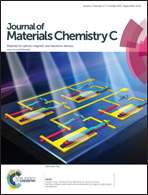Nanoscale CuO solid-electrolyte-based conductive-bridging-random-access-memory cell operating multi-level-cell and 1selector1resistor†
Abstract
Nanoscale (∼28 nm) non-volatile multi-level conductive-bridging-random-access-memory (CBRAM) cells are developed by using a CuO solid-electrolyte, providing a Vset of ∼0.96 V, a Vreset of ∼−1.5 V, a ∼1 × 102 memory margin, ∼3 × 106 write/erase endurance cycles with 100 μs AC pulse, ∼6.63 years retention time at 85 °C, ∼100 ns writing speed, and multi-level (four-level) cell operation. Their non-volatile memory cell performance characteristics are intensively determined by studying material properties such as crystallinity and poly grain size of the CuO solid-electrolyte and are found to be independent of nanoscale memory cell size. In particular, the CuO solid-electrolyte-based CBRAM cell vertically connecting with p/n/p-type oxide (CuO/IGZO/CuO) selector shows the operation of 1S(selector)1R(resistor), demonstrating a possibility of cross-bar memory-cell array for realizing terabit-integration non-volatile memory cells.


 Please wait while we load your content...
Please wait while we load your content...